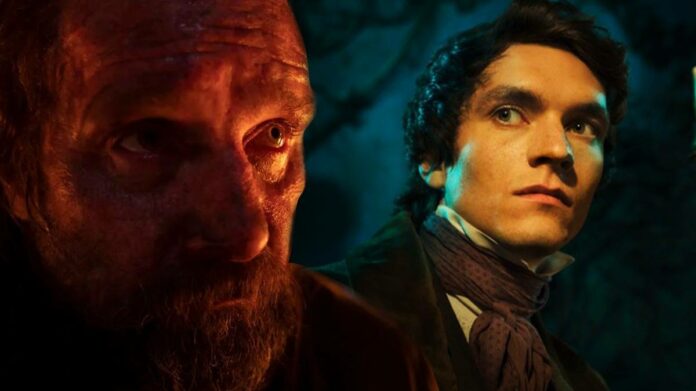“The Great Expectations,” a classic novel by Charles Dickens, has been used and reused for on-screen adaptation multiple times. Be it in British cinema or world cinema; there has been no shortage of interpretations of the story by Charles Dickens. With every adaptation, a filmmaker tends to add his or her style to the story, but what makes Steven Knight’s adaptation any different from all of them in the past?
Spoilers Ahead
Who Is Pip Gargery?
Pip Gargery is a young boy who is in his early teens and lives with his sister Sara and his brother-in-law Joe, who is a blacksmith and runs a blacksmith shop. Pip Gargery has recently lost his parents and his siblings. It is yet to be revealed how exactly they were killed, but it is the year 1892, and it has been only a year since he lost his family. He has been taken in by his sister and brother-in-law. The relationship he shares with Joe is much better than his relationship with his elder sister. Being the eldest, his sister does have a responsibility towards her family, and she expects him to chime in too. Pip is not just an orphan but also a victim of his sister’s violent streak, which he and Joe are used to. Though Joe expects Pip to take over the blacksmith’s shop someday, Pip has bigger dreams for himself. He aims to own a fleet of cargo ships and wants to travel across the world to the colonies of his country, and earn a fortune through trade, accruing worldly knowledge in the process.
One evening, Pip is confronted by a crook named Magwitch, who had escaped the prison ship. Magwitch forces Pip to offer him food and tools to free himself. The boy always had a helpful nature, and this is how it manifested on this occasion. Little did he know he would again be pushed into accepting a deal put across by a friend of Joe, one Mr. Pumblechook. Pumblechook has arranged with the rich and old Miss Havisham to let Pip spend some time with her adopted daughter Estella at the mansion. She wanted the smartest boy of Estella’s age, and the only boy Pumblechook knew who fit the bill was Pip. Pip is confused about what to do from here on—whether to follow his dream or help his family get some extra money. Pip wanted to follow his passion, but for now, that dream must come to a standstill with Miss Havisham’s proposal in hand, as helping his family is a priority. Pip shares the news of living with Havisham and her daughter with his best friend, Biddy. She is concerned about the time he will spend with the girl, but Pip asks her to be more understanding of the financial situation. The boy finally heads down to meet the mother and daughter at the supposedly haunted mansion, thus beginning his journey of living with Miss Havisham and Miss Estella.
What Is Magwitch Up To?
Magwitch, a prisoner on the HMS Retribution, the ship that will transport all the prisoners on board to Australia, wants to kill Compeyson. Compeyson is responsible for something he did to Magwitch that landed both of them in jail. Compeyson had a thing for Magwitch’s wife, which is revealed in this episode. Compeyson and Magwitch are always at loggerheads, and the latter, to cut himself free from the prison ship, starts a fire that leads to both escaping the ship. Magwitch, though, encounters Pip and forces him to get food, drink, and some tools to free himself with. The boy does the same at dawn, only to later witness Magwitch and Compeyson at each other’s throats, followed by their arrest by the police. Magwitch reveals that he frees himself by stealing tools from the blacksmith’s shop. He lets the kid go because he knows Pip has a bright future ahead, something he can see in the kid’s eye. Magwitch ends up back on the prison ship, heading to Australia.
The Bride Is Miss Havisham
Miss Havisham has always been a mystery of sorts in the town, for she always remains aloof inside the humongous mansion that she owns. Miss Havisham does not meet anyone in public that often, and she wants to remain that way for the rest of her life. Over the years, there have been rumors of what happened to her as a person, but her money never ran out. The lady also adopted a girl named Estella, hoping she would carry her legacy forward. But Havisham remains a haunted figure that many in the town will just speculate about. Her idea of introducing Pip to Estella is to make sure her daughter learns how to be in the company of people of the opposite gender, and she is also keen to comprehend how the young boys of Estella’s age behave when it comes to their ideas of companionship and love. When Pip finally gets to see Lady Havisham, she is a woman who has aged but is visibly heartbroken. The lady has not been out of her wedding dress since the day she was left at the altar, a heartbreak so intense she never recovered from it. She would want to put her daughter and Pip to the test to see how far they go and how soon Pip can also become a gentleman.
Review
The first episode set the tone for what this show will all be about. Unlike the previous adaptations by other filmmakers, Steven Knight’s adaptation of the first episode is easy to understand because the tone he wanted to put across is dark. There are no good or bad characters here but just ones with gray shades so that one does not sympathize with only the supposedly good boy Pip Gargley. Charles Dickens’s version is not tragic and dire, where the emphasis is so heavy on Pip’s relationship with his sister and brother-in-law. Here, the sister Sara is an abusive, manipulative woman who wants money to run the show at home, and she does not expect her husband Joe to work as steadily and as hard as before. She is also a control freak who intends for Pip to live under her roof and act entirely as per her will. All of this comes across as a gloomy version of Charles Dickens’s novel. The approach seems interesting, but it does not come across as dark and gloomy as the writer and director want it to be.
This different approach to presenting “The Great Expectations” is so far not working in favor of the writers Brady Hood and Samira Radsi because the overall setup seems forced, and it does not blend well with the intention of the director and creator, Steven Knight. There is no sense of disgust, anger, or shock whenever characters show their negative side, especially Miss Havisham’s and Sara Gargery’s characters. It all seems imposed, and the intent seems to have gotten lost in the screenplay. There has got to be more depth in the main leads, which is lacking—something that is very evident just in the first episode. With the story that everyone knows and has read about, the approach seems bold, but the screenplay could have been more engaging to understand why these characters needed to be ghastly. Hopefully, there will be more to see in the upcoming episodes of the show, and there won’t be any major diversions from Charles Dickens’s original storytelling. Even if they sidetrack from the original literature, the screenplay should make sure to have a solid foundation and backing to be able to justify the change of track.

